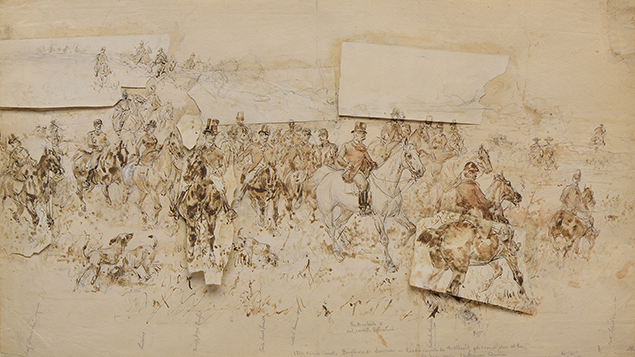(Milan 1828 - 1897)
IL RE ALLA CACCIA NELLA BRUGHIERA DI SOMMA LOMBARDA King Umberto I Hunting in the Moor of Somma Lombarda , 1894
Pen and brown ink, brown washes over traces in black chalk.
Several pentimenti. See here an image of the drawing without pentimenti
365 x 645 mm
Several inscriptions in pencil at the bottom of the sheet, which identify some participants in the hunt. At bottom right the inscription reads 1894 Caccia Cavallo Brughiera di Somma - Quadro eseguito da De Albertis per commissione del Re / Vedi copia presso l’antiquario Valsecchi. It should be noted that we have not found any trace of the painting in the literature relating to the work of De Albertis, but there is a precise photographic documentation of it, preserved in the Milanese Civic Museums.
We know that, returning to Milan after the Second War of Independence, De Albertis developed a close customer relationship with the city's aristocracy and upper middle class. In 1864 he executed a painting in which Prince Umberto, the future king, was portrayed in Monza while he was watching the races. Relations with King Umberto intensified in the last years of the painter's life. In 1880 the king bought La carica dei carabinieri a Pastrengo, exhibited at the Promotrice Torinese. In addition, the artist's first patron is Giulio Litta Visconti Arese, husband of Eugenia Attandolo Bolognini Litta, Umberto's lover. For the noblewoman, the painter made watercolor caricatures and a lithograph portrait of the lady herself.
REDUCED PRICE
previous price was € 6800
De Albertis worked in the studios of the history painters Domenico and Gerolamo Induno and Roberto Focosi while studying at the Brera Academy. His participation in the Brera exhibitions with works of social commitment on historical subjects was initially irregular because of his involvement as a volunteer in the nationalistic uprisings and wars of independence. In 1848, after taking part in the Milanese insurrection known as Le Cinque Giornate, he left the city to participate in the First War of Independence. Back in Milan, his work from 1855 focused on the military and patriotic genre, but also on historical painting and portraits.
At the outbreak of the second war of independence in 1859, he enlisted in Garibaldi's Cacciatori delle Alpi, in the department of the horse guards. Admitted to hospital, for the onset of freezing at his feet, he still managed to participate in the Spedizione dei Mille in Sicily.
Back in Milan again, De Albertis resumed taking part in the Brera exhibitions and, in 1860, he joined the Società de la Confusion with Tranquillo Cremona and Eleuterio Pagliano, as part of the Scapigliatura movement; the group will then be institutionalized in 1875 as the Circolo degli Artisti. The cultural climate gravitating around the Scapigliatura was the background to the artist’s first watercolours and works of a less committed nature depicting events and aspects of contemporary life, including the celebrated horse-racing scenes. In this way his client relationship with the Milanese aristocracy and upper middle class became very close. Prince Umberto di Savoia himself is among the subjects portrayed and will become his client.
The premature death of his only son in 1874 was followed by a return to painting of a patriotic character and marked social commitment.
The recipient of numerous official awards, De Albertis was appointed a member of the committee for the creation of Milan’s Museo del Risorgimento in 1884, together with Cesare Correnti, Giuseppe Missori and Gerolamo Induno. Although he did not hold a proper school of painting, he was the recognized teacher of Emilio Gola.
